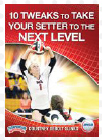|
Six Tweaks to get your Setter to the Next Level By: Courtney DeBolt Slinko Provided by: AVCA
I am often approached by coaches, parents and players that all have the same issue: they aren't playing with consistency. A setter helps a team thrive when they are able to deliver the ball to a specific spot in a way that the hitters can base their approach around. These small tweaks will immediately address areas of concern that affect consistency. Identify the problem, apply some tweaks, and then practice over and over. The repetition is crucial - just applying a tweak doesn't fix a problem overnight. A tweak really takes root when the player is at home working on their own time. As a coach, you don't have time to dedicate entire practices to the detailed actions of a single player. Your setter needs to take some responsibility for their improvement, as well.
The first thing we're going to look at is the thumbs. The hands need to look the same both when you get the ball and when you release the ball. So how do we fix it? Have the setter try some isometric sets against the wall. That's simpler than it sounds - essentially, the player will face the wall and hold the ball up with their hands in the proper position, thumbs even. Have them press the ball hard against the wall, stretching the thumbs out, and hold. This is part of developing the necessary muscle memory. From there, we can try another drill utilizing the wall.
The setter can also try a drill called catch-freeze-set. This breaks down the setting process and shows the player exactly where their hands are supposed to be. Toss the ball to them as if they were going to set. Have them catch and hold the ball in place, noting if their hands are in the proper position. If they are, they can toss the ball out as if they were executing the set. They can do this by themselves at home in the when it's directly over top of their head. It's a yard for however long they want.
Using a weighted volleyball helps emphasize technique and build strength. Many setters will run to the ball, arriving when it's directly over top of their head. It's a maddening habit, and you'll see them do it even when they're already at the net and the ball has been passed perfectly a foot in front of them. Most commonly, the setter will try to claim that they're really good at back-setting. Setters that are used to being directly beneath the ball will almost look as if they're leaning backwards, or they'll set and seem to jump backwards. Every setter that I train barely bends their legs when they first come in. For setters that haven't fully developed their technique yet, adding something like bent legs can be a discomforting thing at first. I like to remind players that if they don't feel right, it means they're making progress. Repetition is the key to successful change. Another great (and affordable) tool you probably have in the gym is the basketball hoop that's already there. This teaches quickness and agility, not to mention you can do this drill just about anywhere. You can even grab a partner and make a competition out of it. Setter training can be repetitive and discouraging -it's nice to mix in some fun drills to keep things lively. Another common issue I hear about is that they tend to trap the outside hitter by setting them too close to the net (or even over it). Two things happen that can cause that - Because it's a habit that develops over time, you'll probably notice your player stepping off the net around 75 percent of the time. It's just second nature at some point. Pay close attention to the location of their feet. Every time they leave the box, point it out and nullify a point. Setters will respond to the competitive factors. The other issue involves the setter at-tempting to square up to the outside hitter and set simultaneously. It can be a hard habit to undo, and when match adrenaline kicks in, that approach to setting is very hard to control from a consistency standpoint. Remember - not every setter is going to have the same issues. The challenge for you as the coach is to notice what's throwing your setter off and helping them work through the right drills to correct minor errors. Repetition is the key to undoing bad habits. For more on studying, analyzing and assisting your full DVD by Championship Productions, featuring even more examples, insights and tweaks to help your setter find the consistency they need to take your entire team to the next level.
|




 Let's say you have a pretty good setter that you want to help become a great setter, or perhaps you coach a team with some great hitters and a decent setter and you just can't get past a certain round in the postseason. When you're looking for that little boost, I like to look at the foundation - let's get the setter operating at a high level on a consistent basis.
Let's say you have a pretty good setter that you want to help become a great setter, or perhaps you coach a team with some great hitters and a decent setter and you just can't get past a certain round in the postseason. When you're looking for that little boost, I like to look at the foundation - let's get the setter operating at a high level on a consistent basis. 

 Let's say your setter has a bad habit of tilting their hands back with the palms up - poorly addressing the ball. This takes any strength coming from their wrists out of the equation and all the energy must come from the arms (which aren't always equally strong, resulting in an imbalance).
Let's say your setter has a bad habit of tilting their hands back with the palms up - poorly addressing the ball. This takes any strength coming from their wrists out of the equation and all the energy must come from the arms (which aren't always equally strong, resulting in an imbalance). they are either transferring their weight laterally when they set, or they are squaring up and setting at the same time. You need to identify which one is the cause of the problem. This is something worth fixing - you can't develop consistency with that kind of movement going on.
they are either transferring their weight laterally when they set, or they are squaring up and setting at the same time. You need to identify which one is the cause of the problem. This is something worth fixing - you can't develop consistency with that kind of movement going on.



